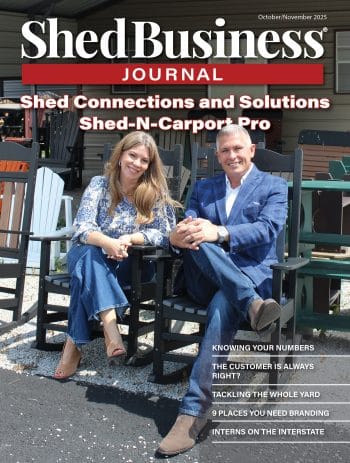How Shed Experts Handle Far-Fetched Requests and Complaints

When your profession revolves around outdoor structures, customer service counts from start to finish. Still, some end-users can have unreasonable expectations or grievances that call for creative solutions and negotiations on occasion.
Let’s take a closer look at whether the customer is always right and how some in the shed industry handle complicated situations.
ACHEIVING SATISFACTION
As a shed builder, Loren Burkholder, owner of Burkholder Buildings in Hines Creek, Alberta, Canada has some stories that stand out.
“We had a customer we built a building for and the whole process went fairly well. He was a bit exacting with the requests, but he was tickled with it after we delivered the shed,” he remembers.
“He was very concerned that this building lined up with another building they had on the property. When you’re building a shed, one inch is huge, but when delivering a shed, one inch is neither here nor there. It’s pretty close. When we were done, he was satisfied, but then he said it was not in the right place and asked if we could come back and move it, so we did. At the end of the day, it was a good customer experience, even though he was way precise, and we moved it another inch.”
Burkholder, who delivers all the buildings, has experienced similar scenarios on multiple occasions.
“One thing I commonly find is that we will move this thing until you’re happy,” he says. “What I have sometimes found is that a building often goes in a corner of a property where there is a fence on the side and a fence on the back of the property. This happens repeatedly that the customer will measure off one fence and another fence.”
In that case, he has to explain that the fences are not square.
“In some town lots, you can measure all day long, but it’s like putting a square building in a yard that isn’t square,” says Burkholder. “You have to be patient. I really do operate under the philosophy that the customer is right. I just try to do it their way until they’re satisfied.”
Other requests have led to unanticipated adjustments.
“For one customer who wanted his shed insulated, I insulated the floor of the shed with strips of plywood underneath and there were gaps,” he recalls. “He was concerned that mice would get through them, so I went back to that shed and lifted it up with my jack and covered it up with plywood to fill in the gaps. I try to go the second mile to please the customer. Is the customer always right? The answer is no, they’re not.”
In the end, the answer to that question may not always determine the outcome.
“As shed builders, the way we handle our customer is very important,” says Burkholder. “I would rather lose a dollar than have an unhappy customer. I will satisfy the customer even if it costs me money.”
Still, he admits there are times when you have to stand your ground in the shed business.
“When a customer asks you to do things you don’t think will work because of your professional knowledge, you can say no. I learned from someone else to never go against your professional knowledge,” says Burkholder who honored a request that was not the best idea because the customer wanted it done.
“I want to please everybody, but what you know won’t work when it comes to satisfying people. You want to pull out all the stops, but you can say: ‘No, I’m sorry. I don’t believe it will work.’”
HIDE AND SEEK
Rachel Oxley, co-owner of Urban Shed Concepts in Phoenix, Arizona, says people can get pretty frustrated with HOA requirements.
“We have a lot of block walls around people’s properties in Phoenix and a lot are 6-feet tall. As long as you can’t see the shed, you can have one, so people try to find ways to get the full height out of their shed and sneak it outside of the HOA,” she says. “We always recommend that you’re better off playing it straight. We never advise to go around their HOA. If they go through the process, a lot of times they will be able to have the right height if they go through the right channels. A lot of times they won’t get it, so it’s a mixture of different policies.”
They do not advise a structure with a 6-foot height.
“If people go above that, they may get caught, so we have them sign off on it if the HOA does not allow it. That’s on you. We are not advising it,” says Oxley. “The only way anybody cares is if a neighbor complains. People get really creative by planting a tree over the shed to try to make it blend in. We don’t want them to call us a few months later to say: ‘Can you guys make this shorter?’ No. They made that decision when they bought it.”
Placing the shed in the right location has also come up. In a lot of those cases, the wife isn’t home when the shed gets delivered and when the wife comes home, she says: “I wish you would have put it here.”
Other customers have unique requests.
“They will try to tell me what they want for the shape of the shed that will go in a very specific spot. We have a lot of very small spaces in Phoenix. They will ask if we can make it into a pie shape,” says Oxley. “Any requests before the sale are obviously easier. A lot of times they are just frustrated, so we try to find a solution and discuss as a question on the sales side and move on to something different if it is not possible.”
One memorable request came from a customer that wanted to build a shed for all the stray cats in the neighborhood.
“They had the whole thing really mapped out,” she says. “We just try to stay positive. We did it and it wasn’t anything out of our scope.”
With the block walls in Phoenix, crane deliveries are common.
“The customer doesn’t always understand what they can get in their space,” says Oxley. “They will want a 6 by 12 shed in a 4 by 10 space, so we do a lot of site visits to say: ‘With this space you can do this, but not this.’ Most things we can catch before the build.”
BACKUP PLAN
Based in Northwest Montana, Jason Kauffman, owner of Kauffman Buildings recalls a customer interaction that could have gone either way.
“It was my second delivery that morning. The customer had an 8 by 8 tiny shed in a ritzy development, and he wanted me to bring it between his garage and a tree which was virtually impossible,” he says. “The customer said: ‘Don’t you have a lift? So, you can lift it over.’ I asked: ‘Can I cut across the neighbor’s property? Do you know your neighbor?’ Then the neighbor came out and said: ‘Do you want me to move the boat?’ I said: ‘Can I move it?’ I have a hitch, so I moved his boat.
“With the wrong person, someone might say screw it. I can’t deliver it, but if you’re a good driver and easy to work with, you can. I have a way of working with the customer.”
ANCHORS AWAY
Tyler Mayhan, marketing director for Better Barns in Paul’s Valley, Oklahoma, still recalls a customer who wanted to build a drive-up DVD rental building back in the day. To house the machine he had purchased, the customer needed an 8 by 8 with a 9-inch sidewall.
The customer asked if the building, which would be anchored to the asphalt in a parking lot, could be built without the floor to be as low as possible.
“The parking lot was sloped quite a lot,” Mayhan explains. “The plan was to build the frame and shave it, so the corner on the uphill side would sit right on the ground and the downhill side would level it out.”
After fitting the floor exactly to the asphalt, which took some time, they got it anchored down.
“That isn’t going to work right there,” said the customer.
“He wanted us to move the floor over about 2 feet. Out in the middle of a huge parking lot, he wanted us to move the floor we had just spent a couple hours on about 2 feet,” says Mayhan.
But they did just that and the customer returned to them for more work after that. Still, Mayhan concludes: Customers are not always right.
LISTEN AND LEARN
In the past, Sam Byler, founder and CEO of the Shed Haulers Brotherhood, a nonprofit corporation of shed haulers united to help each other succeed, has also been asked to move a shed a very short distance.
“The customer said: ‘Can’t you move that little shed with your trailer?’ I didn’t have all the options, but I had a helper when my son would go with me,” he explains.
“The customer would say: ‘I want it right there. No, can you move the front over there a ways a little bit? No, there. That’s better.’ When she said ‘about 3/8ths of an inch that a way,’ I just looked at her for a minute and she said, ‘That’s a little ridiculous.’”
When he offered to grab a board, she declined.
“No,” she told him. “I get a little OCD sometimes. You did a fine job. Don’t worry about it.”
Byler learned important lessons early on in life that stay with him today.
“I grew up with that dad who had a business, and he had a sign that said: There are two rules. The customer is always right. If the customer is wrong, see rule No. 1. I tried to live by that, and I learned a long time ago that the question mark is really important,” he says.
“Sometimes the customer doesn’t know what they want. I wrote an article for the magazine about the shrieker where I ended up taking the shed back. No, we don’t just sit here all day and move these sheds around. There were yard ornaments weaving around and it was hot, so my customer-is-always-right fuse gets a little short when it gets hot.”
As he explains, the customer experience starts before the purchase.
“From the sales side of it, the biggest secret that we never have people talk about is when the customer comes in looking for a shed, they don’t know what they want,” says Byler. “You have to walk them through the process to learn what’s right for them. For the customer order or the delivery, what that customer needs is for the end result to be right when you pull up to do the delivery. And you want to make sure you are doing a walk-through with them.”
A lot can happen between the purchase and the delivery.
“With some of those scenarios, to figure out what that person really needs, we miss out on that,” he says. “Then it’s: ‘I’m done. I moved it four times and I didn’t realize how it was going to look.’”
Even the size can be deceiving to the average homeowner.
“It’s a big item. A customer might say: ‘Oh my goodness. I can’t see that rosebush anymore,’” adds Byler. “With a shed, when it shows up, it’s sitting on a trailer. It looks way big. They say: ‘I had no idea it was going to take up that much room.’ It would be great if we had inflatables. If we’ve got bouncy houses…”
Miscommunication can also lead to problems that need to be solved.
“On the complaint side on deliveries, it helps if you have a salesman who actually knows what he’s selling,” he says. “The customer might say the door wasn’t where they wanted it, or the windows are in the wrong place.”
In some cases, that can be an easy fix.
“About half of the time, it’s simply because of the way it’s loaded on the trailer. If you just listen to them and tell them: ‘It’s okay. We’ll get through this. I’ll fix it here or take it back to the shop and fix it there,’” adds Byler.
“It can get a little bit slippery when you’re running at 150 percent and the shed is not what the customer drew on paper, and you have a ‘ruh-roh’ moment. But she’s never ordered a shed before. I fix it every time. Just fix the shed. But quite a few companies for sure are not going back. The reason we have customers sign off on the order is to protect us on that, but I want to make the customer happy.”
Communication can lead to a resolution.
“The key to the customer always being right is we just want somebody to listen to us. We just want to be heard. When they don’t feel like we’re hearing them, they start losing your trust. I sell on trust, not high pressure,” he says. “If you listen to the customer to understand and you listen to them to learn what they’re fussing about, you can be quick to get them to feel like they don’t have to be right. It honors the question mark when they know I’m going to help them find a solution.”



